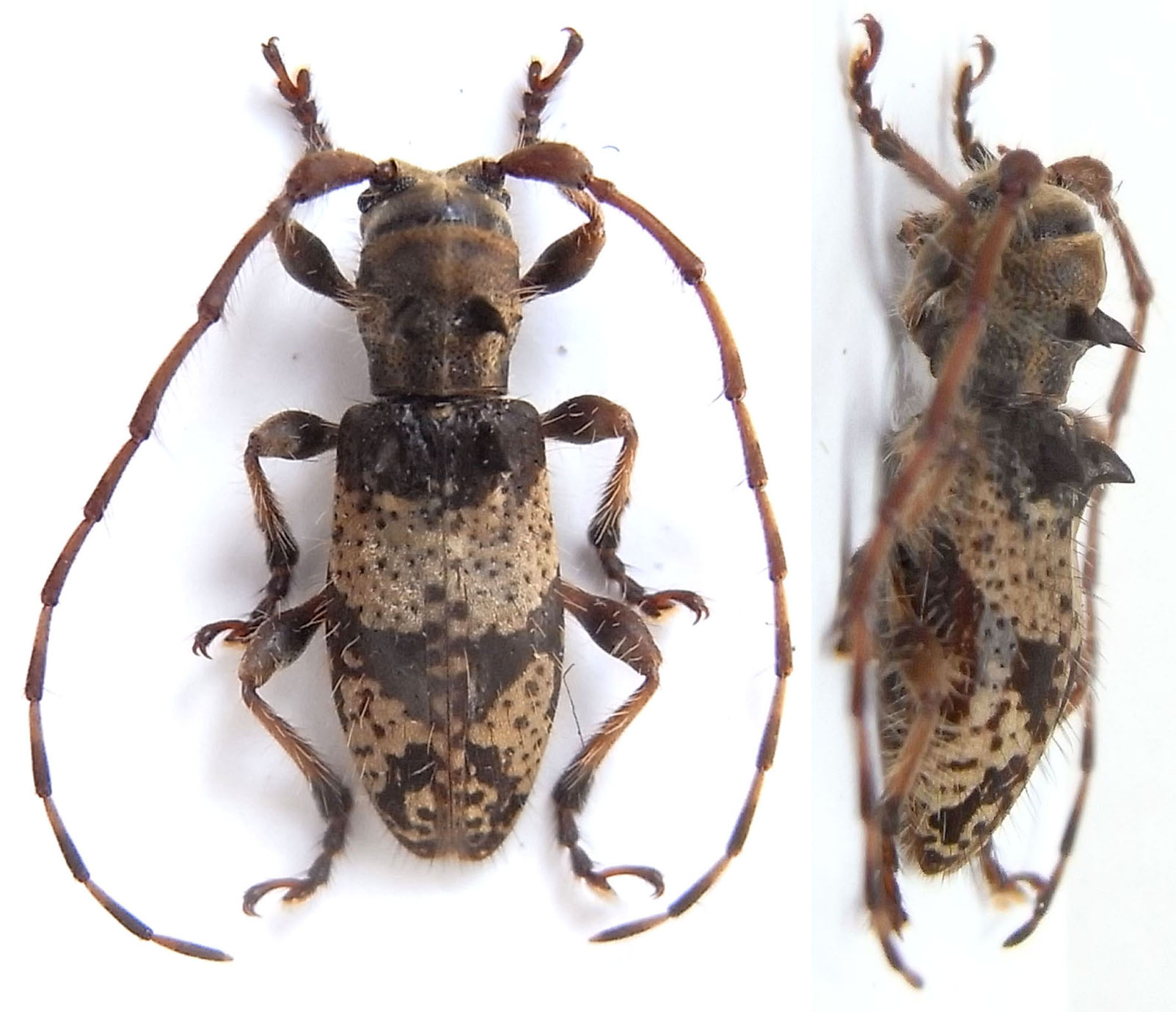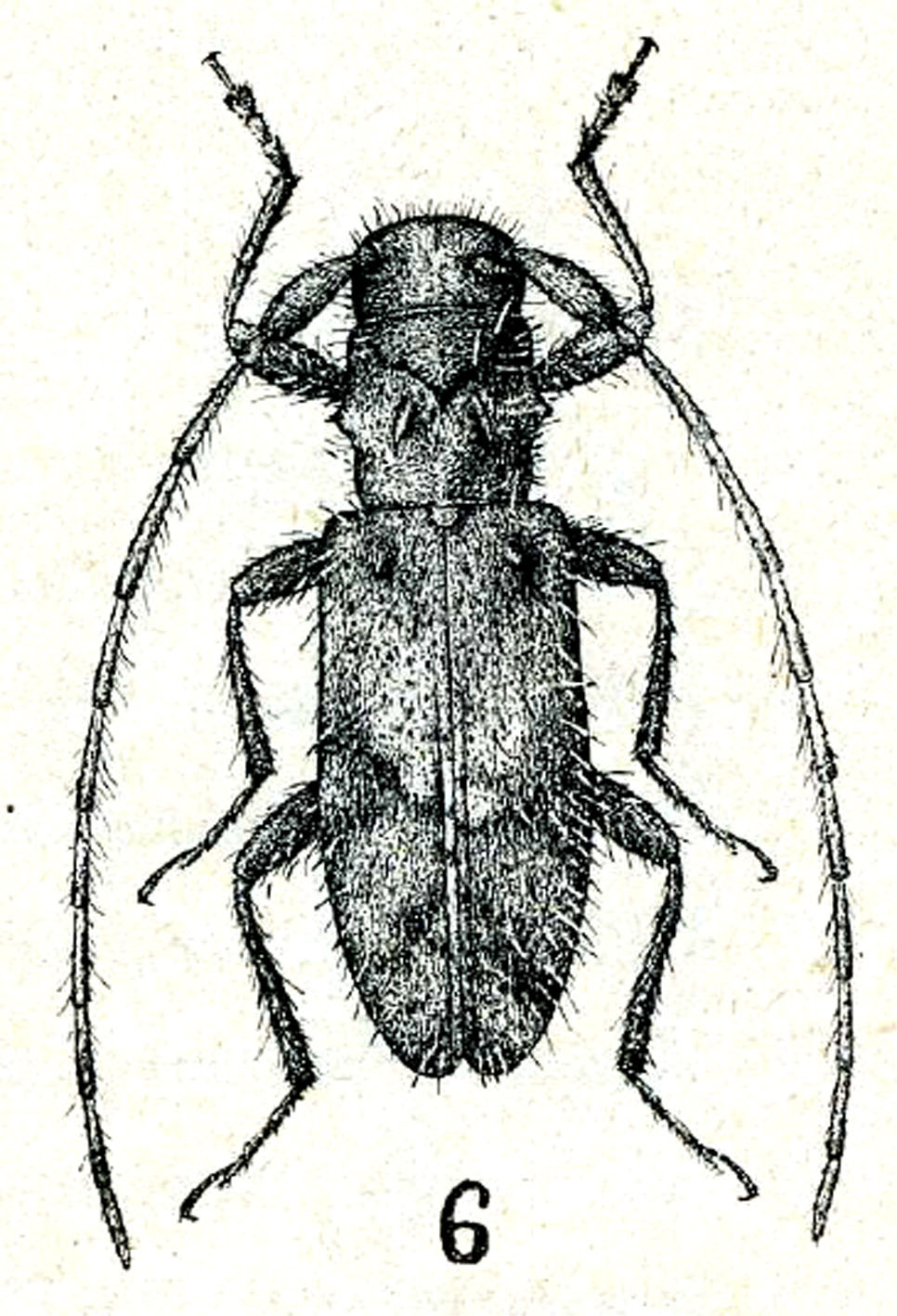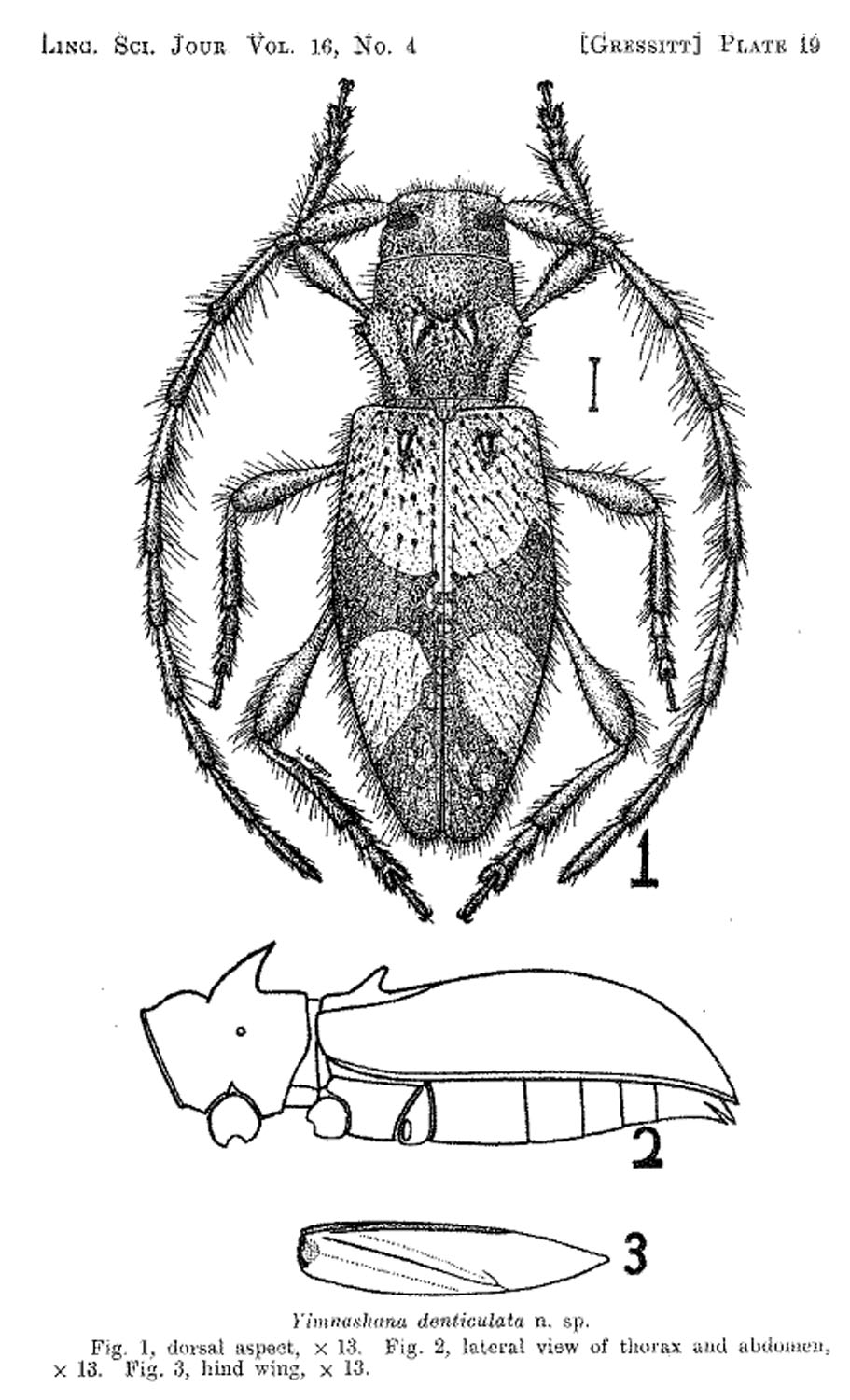| Author |
 Topic Topic  |
|
Xavier
Scientific Collaborator
    
France
12135 Posts |
 Posted - 02/12/2013 : 09:46:39 Posted - 02/12/2013 : 09:46:39



|

6 mm to 9 mm (20 specimens). Hua Phan, north-east Laos.
After seeing the picture's type (many thanks to Tom  ), here a picture of Gyaritus auratus Breuning, 1963 for the forum. ), here a picture of Gyaritus auratus Breuning, 1963 for the forum. |
Edited by - Xavier on 27/10/2014 09:01:43 |
|
|
Xavier
Scientific Collaborator
    
France
12135 Posts |
 Posted - 24/01/2014 : 11:36:19 Posted - 24/01/2014 : 11:36:19



|
Unclear  ,...after looking the type picture of Gyaritus quadridentatus (Pic, 1936) ,...after looking the type picture of Gyaritus quadridentatus (Pic, 1936)
Neither (G. auratus / G. quadridentatus) has bicolor antenna. But the elytral pattern of my specimens seems closer to G. quadridentatus... Any idea ? |
Edited by - Xavier on 24/01/2014 11:42:46 |
 |
|
|
Xavier
Scientific Collaborator
    
France
12135 Posts |
 Posted - 27/10/2014 : 09:00:57 Posted - 27/10/2014 : 09:00:57



|
| Avec BREUNING, 1979. Révision de la tribu des Gyaritini Breun., j'arrive bien à Gyaritus quadridentatus (Pic, 1936) : lobes inférieurs des yeux aussi longs que les joues. |
 |
|
|
nasa
Member Rosalia
  
China
960 Posts |
 Posted - 27/10/2014 : 09:14:23 Posted - 27/10/2014 : 09:14:23



|
| nice guy! |
 |
|
|
Francesco
Forum Admin
    
Luxembourg
9442 Posts |
 Posted - 28/04/2015 : 10:53:21 Posted - 28/04/2015 : 10:53:21




|
| Ce n'est pas un Gyaritus... selon moi, il s'agit d'une Yimnashana. |
 |
|
|
Xavier
Scientific Collaborator
    
France
12135 Posts |
 Posted - 28/04/2015 : 17:39:10 Posted - 28/04/2015 : 17:39:10



|
 . .
Merci. |
 |
|
|
Xavier
Scientific Collaborator
    
France
12135 Posts |
 Posted - 01/05/2015 : 08:52:07 Posted - 01/05/2015 : 08:52:07



|
Que faut-il comprendre ? (je suis perdu)
Les deux espèces proches de mon espèces G. auratus / G. quadridentatus seraient aussi des Yimnashana ?
|
 |
|
|
Francesco
Forum Admin
    
Luxembourg
9442 Posts |
 Posted - 01/05/2015 : 09:06:35 Posted - 01/05/2015 : 09:06:35




|
Le vrai problème est que la clé de Breuning est trompée.
Avec le pronotum épineux il a 5 taxa:
A - métasternum raccourci (aptère ou semi-aptère, élytres ovalaires)
1 - Yimnashana Gressitt, 1937 (yeux normales)
2 - Tinkhamia Gressitt, 1937 (yeux divisés)
B - métasternum normal (ailé, élytres parallèles)
1 - Gyaritus Pascoe, 1858 (yeux normales)
2 - Axinyllium Pascoe, 1864 (yeux divisés)
(Ici il faut se décider à uniformiser la systématique: genres ou sous-genres les deux).
5 - Yimnashaniana jianfenglingensis Hua, 1986 qui est semblable de Gyaritus, même si Hua dit qui est semblable de Yimnashana.
La photo est dans le livre de Hua et al. (2009: 121, Fig. 1406) et voilà sa description:
A new genus and new species of longicorn beetles from China: Yimnashaniana Hua, gen. nov.
Small, elongate, with sparse erect long hairs. Frons subrectangular, slightly convex. Eyes deeply emarginate, facets coarse, the inferior lobe deeper than wide, oblique, distinctly longer than gena. Scape swollen, the internal apex bearing a stout spine.
Prothorax cylindrical, as broad as long, narrower than humeri of elytra, the middle of each side swollen weakly, the lateral tubercles indistinct, on either side of middle of disc bearing a strong, sharp, posteriorly recurving erect tubercule.
Scutellum broadly short, round apically.
Elytra moderate broad, subparallel; the angle of humeri blunt; near the base of disc each bearing a stout and short, blunt, suberect tubercle.
Anterior coxal cavity closed behind, angulate externally, middle coxal cavity opened to mesepimera externally. Tarsal claws divergent.
Type-species: Yimnashaniana jianfenglingensis Hua, sp. nov. (Fig. 1)
This new genus is very similar to the genus Yimnashana Gressitt 1937, but can be distinguished by the following characters: the internal side of each scape bearing a stout spine, the prothorax narrower than the humeri of elytra and the lateral tubercules of prothorax indistinct, etc.
Yimnashaniana jianfenglingensis Hua, sp. nov. (Fig. 1)
Male, Small, elongate, reddish brown, body covered throughout with sparse silvery-white to yellow-brown erect long hairs.
Head reddish brown, eyes and lower margin of external side of mandibles black. Pronotum dark reddish brown. Scutellum reddish brown. Elytra reddish brown, on the disc each with two oblique bands of silvery-white fine pubescence, the first broader, arising from the external margin beneath the shoulder and obliquely directly to the inside of disc, and then passing behind the basal tubercle and reaching to the suture; the second shorter and smaller, situated in the apical fourth, obliquely extending externally backwards and reaching to the external margin. |
 |
|
|
Xavier
Scientific Collaborator
    
France
12135 Posts |
 Posted - 01/05/2015 : 09:23:23 Posted - 01/05/2015 : 09:23:23



|
Bon, je suis d'accord avec toi, et j'attendais que tu déplaces ce post.
G. auratus et G. quadridentatus sont probablement la même espèce, et la mienne est autre chose.
Dès que j'ai le temps, je rassemble tout mon matériel (j'ai beaucoup de spécimens), et je refais des photos plus précises. |
 |
|
|
Xavier
Scientific Collaborator
    
France
12135 Posts |
 Posted - 10/05/2015 : 10:39:54 Posted - 10/05/2015 : 10:39:54



|
La description de Yimnashana lungtauensis Gressitt, 1951 (du sud Chine, en altitude), marche assez bien, sauf pour la longueur des premiers antennomères, mais Gressitt décrit une femelle.
Les dessins noirs des élytres ne sont pas les mêmes cependant.

Yimnashana lungtauensis Gressitt, 1951: Pl. 19. fig. 6
- Ce n'est pas Yimnashana theae Gressitt, 1951 dont Gressitt dit qu'il a les élytres plus larges aux épaules, régulièrement rétrécis jusqu'à l'apex
- difficile de se prononcer sur la description de Yimnashana denticulata Gressitt, 1937, mais le dessin des élytres montre des bandes sombres qui se rejoignent (jamais le cas pour mes spécimens)

Yimnashana denticulata Gressitt, 1937
- Mes spécimens n'ont pas de dent interne au scape, ce qui exclurait le genre Yimnashaniana Hua |
Edited by - Xavier on 10/05/2015 11:46:49 |
 |
|
|
Francesco
Forum Admin
    
Luxembourg
9442 Posts |
 Posted - 10/05/2015 : 13:07:21 Posted - 10/05/2015 : 13:07:21




|
| Selon la clé de Yamasako et al. (2012), Y. theae a les élytres plus larges au milieu. C'est celle-ci qu'il faudrait vérifier. |
 |
|
|
Xavier
Scientific Collaborator
    
France
12135 Posts |
 Posted - 10/05/2015 : 13:49:37 Posted - 10/05/2015 : 13:49:37



|
Au moins deux caractères de la description de Y. theae ne vont pas :
- inferior eye-lobe not quite as deep as gena below : mes spécimens ont les lobes inférieurs des yeux nettement plus courts que les joues
- third segment about as long as scape, not quite as long as fourth; fith shorter than scape, two-third as long as fourth : pour mes spécimens, scape plus court que le segment3, segment 3 = segment4, 5ème = scape
Donc ce n'est pas Y. theae. |
 |
|
|
Francesco
Forum Admin
    
Luxembourg
9442 Posts |
 Posted - 10/05/2015 : 14:09:11 Posted - 10/05/2015 : 14:09:11




|
quote:
Originally posted by Xavier
Donc ce n'est pas Y. theae.
  |
 |
|
|
Francesco
Forum Admin
    
Luxembourg
9442 Posts |
 Posted - 19/05/2015 : 15:33:38 Posted - 19/05/2015 : 15:33:38




|
Grâce aux exemplaires que tu m'as envoyés, Xavier (merci de tout cœur  ), j'ai pu vérifier que l'insecte est brachyptère est les lobes oculaires sont unis par une range d’ommatidies. ), j'ai pu vérifier que l'insecte est brachyptère est les lobes oculaires sont unis par une range d’ommatidies.
C'est donc une Yimnashana... mais, selon moi, il est aussi Gyaritus auratus, qui devrait etre transféré à Yimnashana.
Ah, la clé des dernières espèces est inversée, chose qui explique la faute de Yamasako et al. (2012). |
 |
|
|
Xavier
Scientific Collaborator
    
France
12135 Posts |
 Posted - 19/05/2015 : 21:35:03 Posted - 19/05/2015 : 21:35:03



|
Oui, c'est la solution logique.
Tu es un bon investigateur !  |
 |
|
|
Francesco
Forum Admin
    
Luxembourg
9442 Posts |
 Posted - 20/05/2015 : 00:12:52 Posted - 20/05/2015 : 00:12:52




|
Pourtant les yeux ne correspondent pas: ils sont trop petits pour G. auratus...  .... ....  ... ...  |
 |
|
 Topic Topic  |
|


